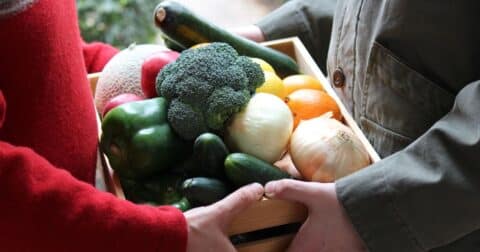Perspective
Critics Declared Veganism Dead in 2025. Here’s What Those Obituaries Are Missing.
Food•5 min read
Explainer
CSAs offer some food system benefits — but are they practical and accessible?


Words by Gabriella Sotelo
You may have heard of a CSA — an initialism that stands for community-supported agriculture — but do you know how they work, and what benefits they provide? The answer might be more complicated than you might think. A CSA is an agricultural model meant to connect people with their food. This model originally emphasized organic and sustainable agriculture as a way to create a transparent local food system, or a food system where people are consuming products in the same area they were produced. In recent years, a growing field of research has shown that eating local is a less effective climate solution than eating less meat. But that doesn’t mean CSAs can’t be part of a climate-friendly diet.
The U.S. Department of Agriculture defines a CSA as “one type of direct marketing, consist[ing] of a community of individuals who pledge support to a farm operation so that the farmland becomes, either legally or spiritually, the community’s farm, with the growers and consumers providing mutual support and sharing the risks and benefits of food production.”
CSAs work by consumers buying shares to a farm for their seasonal harvest. It’s like a subscription-based service, where you pay for a membership to receive a box of produce, usually weekly. By buying a share of a farm’s harvest, you not only get fresh, seasonal produce, but also help support local farmers and promote sustainable practices.
What began with around 60 farms in 1990 using this model has now expanded to more than 2,500 farms across the U.S.
The history of community-supported agriculture in the United States can be traced back to two different areas: Japan and Europe. The concept of CSA seems to have started in Japan in 1965, when a group of women noticed the lack of quality food available to them, and approached a farm to provide fresh produce to their families. The farms said they would, if multiple families also made the effort to support the farm, and from there, what is known as “teikei” was born. Teikei is also associated with the slogan “food with the farmer’s face on it.” This system then found its way to Europe, and finally to the United States in the 1980s.
As mentioned, the basic concept of a CSA is that a consumer is paying to get a share of a farm’s harvest. Determining the share price can be done by a number of methods. Some farms can set their price at market cost, while others can set the price by looking at production costs, farm expenses and more, and then determine the price after talking to members of the community. It varies farm-to-farm.
CSA programs can be found in almost every state around the U.S. The programs connect people with local farms, and when boxes are available can vary. Some are offered year-round, while others have a specific season when they operate their programs. Other things like the subscription period (weekly or yearly), box sizes prices and pickups or deliveries also vary.
Depending on the farm a person supports, the boxes will either come with a predetermined variety of products, or members can choose what they want or need. While pickups can happen at farms, some programs offer designated pick-up points, such as a local farmers market.
The most common products that farms provide are a variety of fruits and vegetables. Some farms will give eggs and honey, while a few provide dairy products and meat in the box.
While the main thing consumers get out of a CSA is direct access to fresh harvest, they are also getting a more direct connection to farms and farmers. Even though many consumers view locally produced food as more sustainable, research shows “sustainability” to be more complicated than simply how far food travels.
To sum up an ongoing, polarized debate: some food system advocates value reduced use of synthetic pesticides and fertilizers and what they see as a more “natural” approach, whereas others argue for a model of “sustainable intensification” — simultaneously shrinking and intensifying farming so as to leave more land uncultivated, where carbon emissions can be stored and biodiversity can thrive. Threads of this debate are often part of discussions over the value of CSAs.
When someone participates in a CSA, they feel like they know where their food comes from. They at least have some contact with the farmer — and some information about how it was grown. Both the farmer and consumer are sharing the risks associated with food production, like if a crop fails. When a crop fails, it is on the farms to decide what to do next, based on the membership agreement. Some agreements state that should a crop fail, members have to understand there will be no refund, while others may offer members the chance to substitute for another crop.
CSA members also often have opportunities to visit the farms, or even participate in picking produce themselves, which helps consumers feel a sense of connection to the farm and foster community.
One of the most significant advantages of CSA programs is the direct financial support they provide to farmers. An upfront payment allows farmers to properly invest in the equipment and seeds needed for growing produce.
Farmers say they are motivated to participate in a CSA for environmental reasons, according to a 2019 survey published in the journal Sustainability. The respondents cited a return to more traditional farming practices and reduced reliance on synthetic pesticides and fertilizers as examples. Other environmental benefits many cited included crop diversity as well as reduced “food miles,” a concept that refers to the distance food travels from where it grows to your plate. Farmers and consumers alike often point to reduced food miles as a climate benefit of eating local, yet research has debunked this idea — transportation plays a small part, just 6 percent of food system emissions. Most food-related emissions come from livestock, mostly burps from cattle and land use that goes to pasture and feed crops.
The biggest contributor to climate pollution from food comes from livestock, which accounts for anywhere from 11 to over 19 percent of global emissions. Cutting down on meat and milk, and replacing half with plant-based options, whether from a CSA or the grocery store, could reduce emissions by a third.
There are some CSAs that do produce meat, which some environmentalists have come to recommend as an alternative to factory farmed meat. The Union of Concerned Scientists described CSA-produced meat as such an alternative in a 2009 fact sheet. But this so-called ‘better meat’ often has a higher climate impact due to more expansive land use, according to research conducted by the World Resources Institute this year.
The main roadblock to participating and proliferating Community-Supported Agriculture is accessibility. In a marketing profile on CSAs, the University of Kentucky notes that CSA consumers are usually “upper-middle class” with “above-average incomes.” This is often the main criticism of CSAs — that they aren’t reaching consumers who could benefit the most from easier access to fresh fruits and vegetables.
A 2023 research study on food justice in CSAs argues that the typical CSA model does not address inequalities in the food system; most programs do not take into account lower-income members, and may set share prices too high for most people to participate.
Obstacles to participating in CSAs include lack of transportation to pick up produce, and lack of awareness on how CSAs work. The lack of choice in products is also a big obstacle. People are uncomfortable paying in advance for a box without knowing what it contains. The researchers write that “for low-income families, these uncertainties are difficult to bear as they are constantly on a tight budget and may not be able to afford a backup option.”
There are actions CSAs can take to be more accessible. Some CSAs will inform people in advance about the products they will get, usually through newsletters. They can also offer flexible payment plans or trial subscriptions for those who may be interested in CSAs, but don’t want to make a full commitment. CSAs can also structure their shares to take SNAP or EBT, which can assist low-income families in buying the food.
Though it’s difficult to pinpoint the exact number of CSAs that accept SNAP, it is worth noting that many farmers’ markets do offer this option. The USDA Food and Nutrition Service states they are committed to expanding access to direct marketing farmers programs, like CSAs, to SNAP recipients. USDA also provides grants through the Gus Schumacher Nutrition Incentive Program, a program designed to increase the purchase of fruits and vegetables to SNAP recipients. CSA coalitions can apply for grants to include people that use SNAP in their programs.
CSAs may not be a fix for climate pollution, but that doesn’t make them a “climate villain,” especially if they can help consumers eat a more sustainable plant-forward diet.
Still, the CSA model is plagued by challenges — these models are often inaccessible or out of financial reach for communities who would benefit the most from better access to fresh food. There are ongoing efforts to address these flaws, such as flexible payment plans and improved communication, to help CSAs broaden their reach. Ultimately, what Community-Supported Agriculture models offer is closer connection between consumers and farmers — a way to strengthen community ties across food systems.